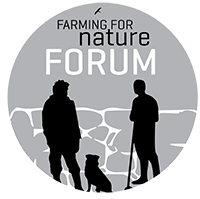Soil
‘Biochar, A Farmer’s Guide’
by Kim McCall
What is biochar, is it relevant for farmers ?
Biochar is the burning of organic material, usually a secondary material from another use ie straw, vine prunings, hedge trimmings, tree surgeon prunings, rushes. They are burnt or pyrolyzed in an oxygen starved environment.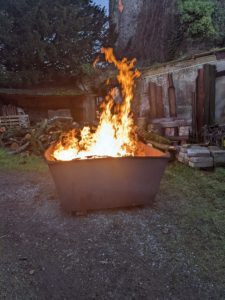
Once biochar has been produced, its use is as an additive for the soil or for any other biological environmental application. Its value to the soil is as a conditioner. It is a material that has a vast amount of micro spaces or pores which can take up water, nutrients, soil microbes, and release them back to plants when they are needed ; in other words, a store house.
When a plant grows, be it a tree or a grass, to photosynthesize it needs sunlight, water and carbon dioxide. The plant gives carbon its solid form in the cell walls. When the plant dies or is harvested by either rotting or being burnt to ash, as in the case of wood, the carbon is released again to become carbon dioxide.
Biochar making is the active method of stopping this process mid cycle and so capturing the carbon and sequestering it in the soil. It could be roughly termed un-mining coal or un-drilling oil. Biochar is non-biodegradable and could last in the soil hundreds, some estimate thousands of years.
What methods are used to make it ?
These can go from a fire pit all the way to a continuous feed pyrolyzing industrial unit costing millions of euros. As farmers and gardeners, we will stick to the methods that are simple and inexpensive. Anyone can produce biochar with simple training. 3 methods are used by farmers or gardeners :
- A burn pit or stack
- A TLUD : top lit up draft gasifier
- A flame cap kiln, for example : Japanese cone kiln, Kon Tiki kiln or Oregon kiln.
The secret of 2 of these methods is the fire is started on the top of the heap and allowed to burn down producing little or no smoke. By so doing, the flame burns the gases above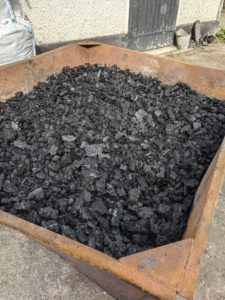 the burning materials (note, a still day is best). The TLUD is slightly different, it involves a double chambered barrel. This produces very clean charcoal. In the fire pit or flame cap kiln, once the fire has burnt down, but not to ash, more of the chosen biomass can be added in small quantities, keeping the fire hot and not letting it smoke (smoke is a sign the fire is not hot enough to burn all the gases efficiently). When either the material being pyrolyzed is finished or your chosen kiln is full, it is important not to let it ash so it has to be quenched either with water or a layer of soil to extinguish the fire and keep the oxygen out so the charcoal does not re-ignite.
the burning materials (note, a still day is best). The TLUD is slightly different, it involves a double chambered barrel. This produces very clean charcoal. In the fire pit or flame cap kiln, once the fire has burnt down, but not to ash, more of the chosen biomass can be added in small quantities, keeping the fire hot and not letting it smoke (smoke is a sign the fire is not hot enough to burn all the gases efficiently). When either the material being pyrolyzed is finished or your chosen kiln is full, it is important not to let it ash so it has to be quenched either with water or a layer of soil to extinguish the fire and keep the oxygen out so the charcoal does not re-ignite.
To get the most benefit from your biochar it needs to be crushed to as small as possible, maximum 1/8 of an inch, dust being best. Once the biochar is crushed, it now needs to be charged with whatever material you choose and so fill the micro pores. It can be added to farmyard manure, slurry, compost, nutrient teas, or feed directly in small quantities to animals. The benefits of biochar are many as well as its uses.
Books for reference: Gardening with biochar, Jeff Cox (good starter book); The biochar solution, Albert Bates ; Burn – using fire to cool the Earth, Albert Bates. There is a mass of information available.
By sequestering carbon back into the soil you will be playing your part in taking carbon dioxide out of the atmosphere.
Good luck, you are now on a journey with no limitations, only your imagination !
‘How to make biochar’
Podcast with Kim McCall
Brigid speaks to Kim McCall about why and how he makes biochar. Kim and his wife Mireille own a 214-acre mixed livestock stock farm in Calverstown, Kilcullen, Co. Kildare with a herd of 75 pedigree suckler cows, a flock of 80 sheep, as well as a few pigs in the summertime.
About Kim McCall
More information and a short film on Kim and Mirielle’s farm here. Ambassador since 2018
‘Building soil fertility on a tillage farm’
By Norman Dunne
There are many different ways you can build soil fertility on a tillage farm. Below are the methods we use.
Albrecht soil te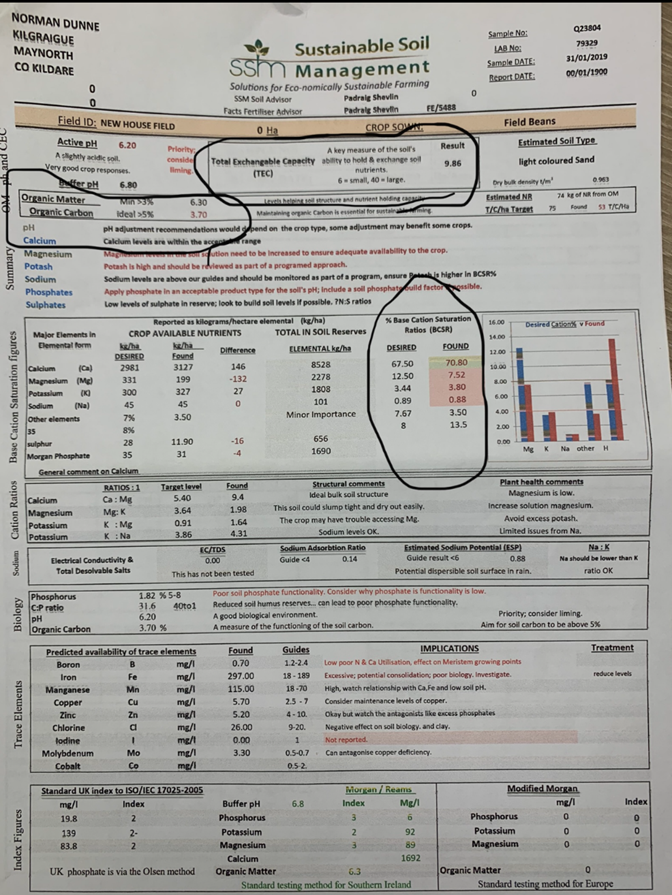 sts
sts
There are 3 main pillars of soil:
- Chemical (nutrients)
- Physical (soil structure)
- Biological (the living)
Dr William Albrecht lived from 1888 until 1974 with most of his work done from 1916 to 1959 at the University of Missouri. His test gives us a base point or starting point as to where we are at with:
- Organic matter;
- Total Exchangeable Capacity (measure of soils ability to hold and exchange nutrients); and
- Base Cation Saturation, this is where the cation percentages are measured. Where we try get our, Calcium, Magnesium, Potassium and Sodium all into balanced ratios. Mainly the calcium magnesium ratio which is calcium 68-79% – Magnesium 10-12% these two are the main bullies within the cations. Getting these in balance should be at the top of the list. We are continually adding kieserite every year which is a natural form of Magnesium Sulphur. This is an ideal amendment for our high calcium soil because the Magnesium is added to bring up our Magnesium and the Sulphur strips the excess Calcium.
Neil Kinsey was a former pupil of Dr Albrecht and has a book called “Hands On Agronomy” I have only scratched the surface with above but the book will explain this in fair more detail than I ever can.
Multi species Cover-crops
- We grow cover crops to build soil fertility. By growing a winter covercrop it covers soil surface protecting it from rain compaction, mops up available soil nutrients, binds soil particles together. The roots of the cover-crop keep the soil open and porous, allowing more water to percolate into the soil profile. And the leaf area of the cover-crop plants act as a solar panel transferring the suns energy down through the root system in what Dr Christine Jones describes as the liquid carbon pathway. These plants use photosynthesis to pump out sugars to feed soil biology in return for on demand nutrient exchange which could be in an unavailable form in soil(eg Phosphorus).
 Autumn/winter cover-crops This is where we will try to get a cover in as early as possible to get the ground covered for winter. So ideally after a winter barley where the covercrop can be sown in late July and be well established come winter. This early sowing also allows us to sow a more diverse range of plants. So we can add a lot more warm season plants with cool season plants (warm season examples; sunflower, buckwheat, clovers, peas etc) these will generally winter kill so you would want to be getting a good duration from them to get value. The later the season goes the less warm season plants will be added to the winter cover mixes. So from the first week of September on we will pull most of the warm season species. Sticking to tillage radish, mustard, linseed and some cheaper legumes or even home saved oats.
Autumn/winter cover-crops This is where we will try to get a cover in as early as possible to get the ground covered for winter. So ideally after a winter barley where the covercrop can be sown in late July and be well established come winter. This early sowing also allows us to sow a more diverse range of plants. So we can add a lot more warm season plants with cool season plants (warm season examples; sunflower, buckwheat, clovers, peas etc) these will generally winter kill so you would want to be getting a good duration from them to get value. The later the season goes the less warm season plants will be added to the winter cover mixes. So from the first week of September on we will pull most of the warm season species. Sticking to tillage radish, mustard, linseed and some cheaper legumes or even home saved oats.- Uncomposted dung. It is at this point that’s it good to apply some uncomposted dung. As time will be running out to store manure or dung outside. What ever hasn’t being fully composted should be spread onto the growing covercrop. The cover crop will effectively compost the rest with its diversity and soak up the nutrients into it’s biomass. Only to return these nutrients back to the next cash crop.(nutrient cycling) both will feed soil biology for the winter period. Below is September sown covercrop after spring wheat which received uncomposted dung.
- Double cover crops, This is a system taken from Gary Zimmer. His book “The Biological Farmer” is a helpful book. He grows two consecutive multi species covers to feed soil biology and build fertility. We copied this to a certain degree, we grow a winter covercrop and come back in with a summer covercrop in April. Back to back covercrops which means the field is fully out of production for a full year. Sometimes but not always we will graze these covers. Depending on the availability of store lambs etc. Sowing in April we can put a massive diversity of seeds in from
-
- Daikon radish,
- Phacelia,
- Vetch,
- Berseem clover,
- Linseed,
- Oilseed radish,
- Mustard,
- Sunflowers,
- Black oats,
- Buckwheat,
- Forage rye,
- Fodder rape,
- Leafy turnip,
- Peas,
- Spinach,
- Any available vegetable seeds that were left over from the year before(good for kids foraging)
-
The above mixes vary for year to year depending on seed availability and rotations.
Gary Zimmers method involves incorporating the covercrop into the soil. We prefer to mulch the covercrop in late summer with a flail type topper (like the head of a hedge cutter) we do this to try and balance the carbon-nitrogen ratio of the covercrop. Some of the plants will get quite woody (carbon) and some of the plants will stay leafy (nitrogen) we try not let it get too woody as it will take more nitrogen to break down the stem or woody material. Our optimum C:N ratio is 24:1 for desired decomposition of our crop residue. The ratio 24:1 is the proper carbon and nitrogen that a microorganism must have in order sustain its health. We also don’t want the covercrop to go to seed. As this can cause different problems down the line. Once the cover is mulched it creates a soil amour. We will direct drill a winter cash crop into this in September either winter wheat or winter barley. The fertility has being built, the structure has being built. Earthworms have exploded in numbers and the soil is visible darker and more aggregated. The diversity is the key here.
Seed Inoculation
-
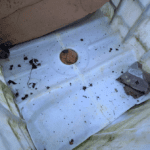
May not improve soil fertility long term but in the short term the biological seed treatment has beneficial effects on the growth, resilience of the plant, abiotic stress, the development of the root system, and the productivity of the crop. An overview of positive attributes of microbials depending on the organism.
- Biological seed treatments acts as a biostimulant: a treated crop becomes stronger and grows better.
- The treatment enhances the crop helping plants to fight off plant pathogens and minimise stress.
- The plant growth promoting microorganisms colonize the roots and protect the crop during the entire growing season.
-
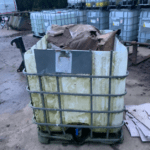
Seed treatment increases the availability of plant nutrients in the root system and increases nutrient uptake.
- The enhanced root and shoot growth means that the early growth rate is optimized and you get even establishment.
- We dress our our seeds with vermi liquid from a home made worm bin made from an ibc tank with the lid cut off and placed at the bottom with holes drilled into it. See pictures attached.
- We also use seaweed, humic and some KNF (Korean natural farming) inputs to inoculate seeds.
Combi crops
-
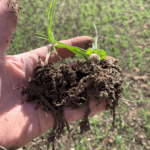
For the past two years we have being growing combi crops, this is where we will grow two or more crops together at one time with the hope of separating them after harvest. We have successfully grown barley and peas, oats and peas with good success. The peas are legumes so they can fix atmospheric Nitrogen and help the cereal crop they also have an acidic root exudate which helps make Calcium bio available. Both plants work together and have a diverse root pattern and symbiotic relationship.
- This year we have grown oilseed rape with an Austrian winter pea. Companioned with buckwheat and berseem clover. These will most likely winter kill leaving just the peas and oilseeds. But before they do, the buck wheat which has a mycorrhizal association. Will make Phosphorus which is locked up and unavailable, freely available to the growing plants.
- Also this sort of diversity can be confusing for pests such as aphids, flee beetles and some birds such as pigeons who like to eat oilseed rape.
Compost
-

Compost is the icing on the cake for us. We use all of our own straw in this process. Which is done with our neighbours windrow machine. Once the the horse manure and straw has being turned 4-6 times to give every all the material a chance to be at a hot temperature in the middle the compost is ready to spread.
- This is a highly humidified compost with all of the nutrients binded and safe. Meaning that we can spread relatively low amounts on the soil or growing crop.
- We try and spread it thinly over our whole farm.
- The slow release of the compost means it’s ideal soil feed and doesn’t overindulge any growing plant making them too lush or lodge a crop.
About Norman Dunne
More information and a film on Dunnes’ farm here. Ambassador since 2021

